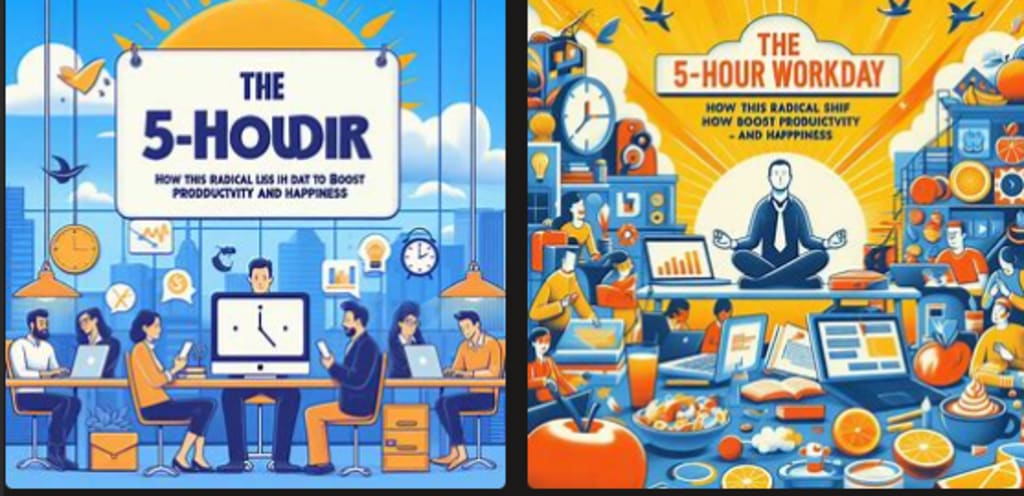The 5-Hour Workday: How This Radical Shift Can Boost Productivity and Happiness
The 5-Hour Workday

Introduction
Imagine leaving work at 1 PM every day, having completed a full and productive workday. This isn't just a dream; it's a reality for some companies experimenting with the 5-hour workday. As discussions about work-life balance and productivity gain momentum, the 5-hour workday emerges as a radical yet intriguing concept. This article explores how a shorter workday can potentially boost productivity and happiness, while also addressing the challenges and providing a roadmap for implementation.
The Concept
The idea of a shorter workday isn't entirely new. Historical figures like Henry Ford championed the 8-hour workday, which was revolutionary at the time. Today, the conversation has shifted towards even shorter workdays. The 5-hour workday aims to condense the essential tasks of the day into a more focused, efficient timeframe, allowing employees to enjoy more personal time without sacrificing productivity.
Benefits
Numerous studies and real-life examples suggest that shorter workdays can lead to higher productivity and improved employee satisfaction. For instance, a study by Stanford University found that productivity per hour declines sharply when a person works more than 50 hours a week. By focusing on core tasks and eliminating distractions, employees can accomplish more in less time, leading to better overall performance.
Case Studies
Tower Paddle Boards: This company implemented a 5-hour workday and saw impressive results. Employees reported higher levels of happiness and job satisfaction, while the company's revenue and profits increased. The founder, Stephan Aarstol, noted that the change forced employees to work smarter and more efficiently.
Rheingans Digital Enabler: This German company adopted a 5-hour workday and experienced similar positive outcomes. Employees were encouraged to focus intensely during their work hours and avoid non-essential activities. As a result, productivity rose, and employees enjoyed a better work-life balance.
Challenges and Criticisms
Despite the potential benefits, the 5-hour workday isn't without its challenges. Critics argue that certain industries, such as healthcare and customer service, require longer hours to meet demands. Additionally, some worry that the pressure to perform within a condensed timeframe could lead to increased stress rather than reduced.
Solutions
To overcome these challenges, companies can:
Adjust Expectations: Clearly define the core tasks and priorities for employees, ensuring they understand what must be accomplished within the shorter workday.
Flexible Implementation: Introduce the 5-hour workday gradually or in specific departments to test its effectiveness before a full-scale rollout.
Encourage Focus: Promote a work culture that minimizes distractions, such as unnecessary meetings and excessive email use, to maximize productivity during the shorter hours.
Expert Opinions
Experts from various fields support the idea of shorter workdays. Psychologists argue that reducing work hours can lower stress and improve mental health. Economists suggest that a happier, healthier workforce is more productive and less likely to take sick leave. Workplace productivity specialists emphasize the importance of focused work and the benefits of a well-rested, motivated employee base.
Practical Guide
For companies interested in trying out the 5-hour workday, here is a step-by-step guide:
Pilot Program: Start with a pilot program in a specific team or department to assess feasibility.
Set Clear Goals: Define clear productivity goals and expectations to ensure essential tasks are completed.
Provide Training: Offer training on time management and efficient work practices to help employees adapt.
Gather Feedback: Regularly collect feedback from employees and make adjustments as needed.
Tips for Employees
Employees can also benefit from tips on managing their time effectively within a shorter workday:
Prioritize Tasks: Focus on high-impact tasks first to ensure critical work is completed.
Eliminate Distractions: Create a distraction-free work environment to maintain concentration.
Take Breaks: Short, regular breaks can help maintain focus and prevent burnout.
Conclusion
The 5-hour workday is a bold and innovative approach to modern work culture. By promoting efficiency, focus, and a healthier work-life balance, this radical shift has the potential to boost both productivity and happiness. As more companies explore this concept, the future of work may indeed see a transformation towards shorter, more fulfilling workdays.
Engagement Strategies
Interactive Polls: "Would you be more productive with a 5-hour workday?" – Include this poll in the article to engage readers.
Social Media Challenge: Use the hashtag #5HourWorkday to encourage people to share their thoughts and experiences.
Comments Section: Invite readers to share their opinions and any experiences they have had with different workday lengths.
By fostering a discussion on this innovative approach, we can collectively explore new ways to enhance productivity and improve the quality of life for workers around the globe.
About the Creator
Enjoyed the story? Support the Creator.
Subscribe for free to receive all their stories in your feed. You could also pledge your support or give them a one-off tip, letting them know you appreciate their work.





Comments
There are no comments for this story
Be the first to respond and start the conversation.